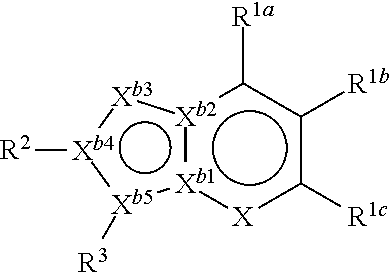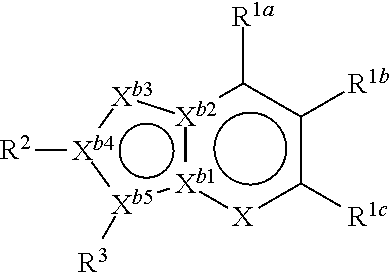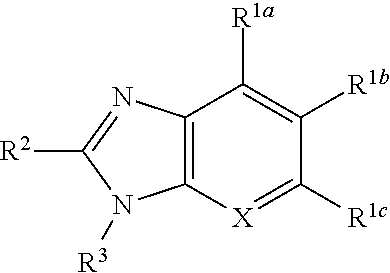Novel antiplatelet agent
a technology of antiplatelet and antiplatelet, applied in the field of new antiplatelet agents, can solve the problems of not providing antiplatelet function, different characteristics, increased bleeding risk, etc., and achieves the effects of reducing platelet aggregation, not accentuated bleeding risk, and strong antithrombotic action
- Summary
- Abstract
- Description
- Claims
- Application Information
AI Technical Summary
Benefits of technology
Problems solved by technology
Method used
Image
Examples
example 1
1-(6-methoxypyridazin-3-yl)-2-pyridin-2-yl-5-(trifluoromethyl)-1H-benzimidazole
[0296]
[0297]To a pyridine (27.5 ml) solution of the compound 1 (2.75 g) (the same compound as that described in Reference Example 2) was added picolinic acid chloride hydrochloride (4.67 g) at 0° C., and the mixture was stirred for 1 h at room temperature. After the reaction mixture was concentrated, the concentrated residue was purified by a silica gel column chromatography affording a crude compound 2 (4.08 g). The obtained crude compound 2 (4.08 g) was diluted in acetic acid (40 ml), and the solution was stirred at 80° C. for 20 h. The solution was kept standing to cool to room temperature, then after being concentrated, chloroform was added to the concentrate, and the resulting solution was washed with a saturated sodium bicarbonate solution. The organic phase was concentrated, and then purified by the silica gel column chromatography. To the obtained residue was added a solution of ethyl acetate / n-he...
example 2
2-(6-fluoropyridin-2-yl)-1-(6-methoxypyridazin-3-yl)-5-(trifluoromethyl)-1H-benzimidazole
[0299]
[0300]The compound 1 (the same compound as that described in Reference Example 2) (300 mg) was dissolved in methylene dichloride (5.3 ml), and thereto were added 6-fluoro-2-pyridine carboxylic acid (156 mg), EDCI-HCl (304 mg) and HOBt-H2O (267 mg). After stirring the solution all day and all night, water and potassium carbonate were added thereto, and insoluble materials were filtrated. The organic layer was washed with water, followed by evaporation of the solvent in vacuo, and the residue was purified by the silica gel column chromatography affording the compound 2 (289 mg).
[0301]MS m / z 408 [M+H]+, APCI(+)
[0302]The compound 2 (100 mg) was dissolved in a mixed solvent of xylene / acetic acid (4:1, 2 ml), and heated to 170° C. by irradiation of microwave. After the reaction solution was stirred for 1 h and kept standing to cool to room temperature, the solvent was evaporated in vacuo. The re...
example 3
1-(6-methoxypyridazin-3-yl)-2-pyridin-2-yl-5-(trifluoromethoxy)-1H-benzimidazole
[0304]
[0305]The compound 1 (the same compound as that described in Reference Example 3) (0.82 g) was dissolved in DMF (15 ml), and to the solution were added picolinic acid (505 mg), HATU (2.08 g) and diisopropylethylamine (951 μl). After stirring the solution all day and all night, water was added thereto, and the solution was extracted with ethyl acetate. The organic layer was washed with a saturated aqueous solution of sodium chloride (or saturated saline), and the organic layer was dried with anhydrous sodium sulfate. After filtration and evaporation, the evaporated residue was purified by the silica gel column chromatography affording a crude compound 2. To the crude compound 2 was added ethyl acetate / n-hexane (1 / 2), and the precipitate was filtrated affording the compound 2 (0.11 g).
[0306]MS m / z 406[M+H]+, APCI(+)
[0307]The compound 2 (14.0 mg) was dissolved in acetic acid (1 ml), and the solution w...
PUM
| Property | Measurement | Unit |
|---|---|---|
| weight | aaaaa | aaaaa |
| weight | aaaaa | aaaaa |
| temperatures | aaaaa | aaaaa |
Abstract
Description
Claims
Application Information
 Login to View More
Login to View More - R&D
- Intellectual Property
- Life Sciences
- Materials
- Tech Scout
- Unparalleled Data Quality
- Higher Quality Content
- 60% Fewer Hallucinations
Browse by: Latest US Patents, China's latest patents, Technical Efficacy Thesaurus, Application Domain, Technology Topic, Popular Technical Reports.
© 2025 PatSnap. All rights reserved.Legal|Privacy policy|Modern Slavery Act Transparency Statement|Sitemap|About US| Contact US: help@patsnap.com



